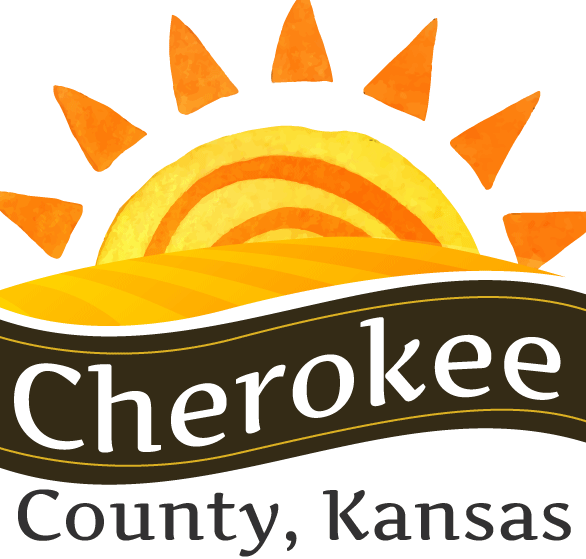Bull Thistle
Description
Pignut · Hoffmannseggia glauca (Ortega) Eifert · has deep roots on which develop nut-like tubers 10- to 15-inches below the surface and are difficult to remove from the soil. This plant is a herb, the stems of which are 8- to 12-inches high, with a tuft of leaves at the base. The leaves are twice divided, 3- to 5-inches long, and there are usually 3 to 5 pairs of leaflets. The leaflets are oblong in shape, and from 1/12- to ¼-inch long. The leaves have characteristic glandular dots. The flowers are of the pea-type, yellow or orange-red, and about one half inch long. The ovary of the flower is covered with peculiar tack-shaped glands. The pods are flat, about 1- to 1½-inches long, and few to several seeded.
Specific Controls
Cultural Control Practices
Cultivation - Cultivate three to five inches deep at intervals so as to permit the weeds to grow not more than 10 days after each emergence of first plants, but not to exceed intervals of three weeks. Cultivation shall be continued until the plants have been eradicated or have been suppressed to such an extent that remaining plants may be more economically destroyed by other treatment, as the application of approved chemicals to individual plants or by hand cultivation. Small infestations should be grubbed out, taking care to remove all the tuberous nut-like roots.
Approved Herbicides
The following herbicide may be used for cost-share with landowners. Other products labeled and registered for use on this noxious weed in Kansas may be used in accordance with label directions but are not available for cost-share. Picloram (Tordon) · (Restricted-use pesticide). Do not apply to cropland. Follow label directions and precautions.
Bur Ragweed
Description
Bur Ragweed · Ambrosia grayi (A. Nels.) Shinners · (formally known as Woollyleaf bursage, but aka woollyleaf povertyweed, woollyleaf franseria, or lagoonweed) is a perennial forb that is native to Kansas. It flowers from August through October, and reproduces through rhizomes and seeds. Its flowers are yellowish-green, and leaves are irregularly lobed and silvery, especially the lower surface. Its fruit is bur-like with 2 apical beaks and up to 13 other spines, formed by floral bracts (1.5-2 mm long), tips of spines slender, hooked at the tip; 2-seeded.
Habitat·
Bur Ragweed occurs in moist places of fields, rangeland, and roadsides. It often grows in saline soils. It occasionally accumulates nitrates, but it is unpalatable. This is an aggressive weed that spreads quickly, forms large colonies, and crowds out desirable plants. Tillage sometimes spreads the rhizomes.
Canada Thistle
Description
Canada Thistle · Cirsium arvense (L.) · is a colony-forming perennial. Not native to North America, it was introduced in the late 18th Century from Eurasia. It is most often found in cultivated fields, pastures, and waste places.
Vegetative Characteristics
A mature Canada Thistle plant is 2 to 5 feet tall, branching at the top. The leaves are 4 to 8 inches long, usually dark green with spiny serrated edges. Buds are pea size, flowers are 3/4 of an in inch or less in diameter and purple to rose in color.
Reproductive Characteristics
Canada Thistle reproduces by seeds and roots. Male and female flowers are produced on separate plants. Consequently, individual plants (and in some instances entire patches) may be seedless. Seeds are dark brown and only 1/8 inch long. Roots are abundant, deep and creeping, forming a dense patch much the same as bindweed.
Specific Controls
Methods of Control Timely herbicide application is the best method to control Canada Thistle. Approved chemicals for control are:
-
2,4-D
-
Tordon
-
Banvel
-
Telar
Notably Counter-Productive Methods
-
Cultivation is not an effective method of control.
-
Chopping up the roots only increases the plant population.
Factors for Best Control
-
Early identification and herbicide applications in the rosette stage are most effective.
-
For ground application, apply herbicides in 10 to 20 gallons of water per acre.
-
Repeat applications may be necessary to prevent seed production and reduce infestations.
Field Bindweed
Desciption:
Field Bindweed · Convolvulus arvensis L. · is a perennial broad-leaved plant that spreads over the soil and other structures, and often form mats. Leaves alternate along the stem. Leaf size and shape will be varied; typically leaves are up to two inches long and egg-shaped.
Flowers are typically white, but often they are light pink and have two leaf-like structures half-way between the main stem and the base of the flower, which is a distinct characteristic.The flowering stage is when most field bindweed is noticed.
The root system is what makes the weed so hard to control. Roots can extend to as far as 30 feet deep. These roots compete with crops for moisture and nutrients, and give field bindweed an advantage over the newly seeded crops by already being in the soil.
Seed pods are egg-shaped, 1/4" in diameter, and contain two to four seeds. Seeds are shaped like a slice out of an orange, small (only 1/8" long), and covered by rough raised dots. Though small, these seeds can lay dormant for as long as 30 years.
Field Bindweed is a noxious weed that can be a severe problem in the largest field or the smallest garden in Shawnee County. A summer herbicide treatment will control existing growth and eliminate seed production. For lasting control, a three-phase treatment plan should begin at first blooming and continue through fall:
Phase I
Treat Field Bindweed with an approved herbicide or control measure shortly after flowering blooms appear.
Phase II
Retreat new bindweed growth approximately 30 to 45 days after the initial treatment or when 12" - 18" runners exist.
Phase III
Retreat returned bindweed growth with an approved systemic herbicide after the first frost in the fall, but before nighttime temperatures reach 20°F.
Specific Controls
Chemical Control
The herbicides which have been approved for County Weed Departments to Cost-Share with landowners are:
-
Roundup - 2.5 gallon & Dry Pak (small quantity) containers:
Kills bindweed and all other green vegetation with no residual.
-
row crops when soybeans are in the rotation
-
vegetable gardens and flower beds after a light frost
-
fence rows
-
-
Picloram 22K - 2.5 gallon containers.
Kills bindweed and other broadleaves, but does not kill grass. Has a residual.
-
restricted use product
-
continuous wheat
-
feedlots and waste areas
-
pastures and CRP
-
-
2,4-D Amine - 2.5 gallon containers
Kills bindweed and other broadleaves, but does not kill grass.
-
large manicured grass areas
-
used mostly as a tank mix with other products
-
-
Speedzone - 20 ounce and 1 gallon containers
Kills bindweed and other broadleaves, but does not kill grass.
-
yards and small grass areas
-
spot applications
-
-
Tyta luctuosa / Bindweed Moth
-
bio-control insect that feeds on Field Bindweed
-
should be used in conjunction with other control measures
-
Factors for Better Control
-
Apply herbicides during active growth when the plant is in the bud stage to early bloom with good soil moisture and when 12 to 15 inches of growth is present.
-
For ground application, apply in 10 to 20 gallons of water per acre.
-
For aerial application, apply 3 to 5 gallons of water per acre.
-
Retreat areas with herbicides(s) or cultural methods to prevent seed production and reduce new infestations.
Hoary Cress
Description
Hoary Cress · Cardaria draba (L.) Desv. · (aka whitetop, whiteweed, and perennial peppergrass) is a perennial Forb that originated in Eurasia. It flowers from April through June, and reproduces through rhizomes and seeds.
Found in pastures, smallgrain fields, roadsides, ravines, meadows, and waste places, livestock will graze hoary cress, but only when better forage is unavailable. Its seed are eaten by ground-foraging birds. The foilage of hoary cress contains a substance causing irritation to mucous membranes of animals. It is only a problem when forage is in short supply.
Hoary cress is an aggressive weed that often forms large, dense stands which are difficult to eradicate or control.
Johnson Grass
Description
Johnson grass · Sorghum halepense (L.) Pers · is a perennial, noxious weed native to the Mediterranean region and was first identified in Kansas in 1880.
It has moderate forage value, however hydrocyanic acid formed in the plant under frost or drought stress renders it poisonous to livestock.
It spreads rapidly by seed or its vigorous rhizome structure. A single mature plant may produce over 80,000 seeds and 200 feet of rhizomes. The seed can remain viable in the soil for up to 25 years and will begin producing lateral rhizomes 6-9 weeks after germination.
Crop Losses
Johnson Grass is one of the most costly weeds with which farmers must contend. It costs them millions of dollars each year in lost crops, poor quality grain and lower crop yields. Five Johnson Grass stems per .0001 acre reduces soybean yields by 4.2%; 50 stems reduce yields by 23% and 340 stems, 88%. One Johnson Grass head per 3.3 feet of grain sorghum row reduces yield by 52 pounds per acre while 50 heads per 3.3 feet reduce yields by 50%. A single plant at maturity may produce over 80,000 seeds and more than 212 feet of rhizomes. Johnson Grass seed can remain viable in the soil for up to 25 years.
Specific Controls
Prevention of Spread
Preventing seed production and its spread is of primary importance. New infestations of Johnson Grass may be reduced by planting Johnson Grass-free seed, using livestock feed that is free of Johnson Grass seed, and cleaning machinery before leaving infested fields.
Cultural Control Practices
Control of Johnson Grass shall mean preventing the production of viable seed and destroying the plant's ability to reproduce by vegetative means. Control may be achieved by chemical, cultural or mechanical means, or by combinations of these methods.
Cultivation may begin any time during the growing season and shall cut off all the weed plant at each operation (use duckfoot or blade type implement). Cultivations shall be 3 to 5 inches deep at intervals of 14 to 18 days. When the plants have so weakened that they emerge more slowly, the cultivation intervals may be extended to such time as will permit the plants to grow not more than ten days after each emergence of the first plants, but not to exceed intervals of three weeks. Cultivation shall be continued until the weeds have been eradicated or suppressed to such an extent that remaining plants may be more economically destroyed by application of approved chemicals to individual plants or by hand cultivation.
In yards, flower gardens, lawns, and around trees and shrubbery, hoeing and other effective means of thoroughly cutting the weeds at regular intervals, not to exceed 14 days during the growing season, shall be construed as intensive cultivation.
Close grazing or mowing at 2 or 3 weeks intervals through the growing season and followed by late fall plowing to expose the root stalks through the winter is a accepted control practice.
Approved Herbicides
The following herbicides may be cost-shared with landowners. Other products labeled and registered for use on this noxious weed in Kansas may be used in accordance with label and directions but are not available for cost-sharing.
-
Generic Roundup - 2.5 gallon containers
Kills Johnson Grass and all other green vegetation with no residual
-
row crops and cereal grains
-
fence rows
-
ditch banks
-
feedlots and waste areas
-
CRP
-
LIMIT 10 GALLONS WITHOUT A PROPERTY INSPECTION
-
Outrider® herbicide controls a wide range of weeds on roadsides and unimproved non-crop sites. Whether you need pre- or post-emergent control, Outrider offers:Excellent control of Johnsongrass and other weeds, without injury to Bermudagrass and Bahiagrass
-
Greater safety on wildflowers than current products
-
Greater control of annual and perennial broadleaf and grass weeds, such as Ragweed, Sunflower, Quackgrass, and many more.
-
Mechanical/Cultural
-
fall tillage and cold weather will reduce Johnson grass
-
early and continuous grazing can eradicate Johnson grass
-
repeated mowing will eliminate seed production and reduce plant vigor
-
the county has a pipe wick applicator available for landowner use
-
Factors for Best Control
-
Use properly calibrated equipment.
-
Timely application
Kudzu
Description
Kudzu · Pueraria montana var. lobata (Willd.) Maesen & S.M. Almeida · is a long-lived, coarse, viney legume that covers the ground with long runners. The leaflets are found in groups of three (5-20 cm. in length). The leaflets are 2-3 lobed and abruptly taper to a pointed tip. The stems have rough bark-like covering. Large flowers, 15-20 cm., lavender to purple, set on seeds sparingly, because of sparse blooming. The seed pods, 4.5 to 5 cm. in length, are papery and covered with fine hair. The long runners root at the nodes to form new plants. Crowns taken from old stands are used for planting.
Prevention of Spread·
The occurrence of new infestations of Kudzu can be reduced by preventing the movement of root crowns or seed from infested areas.
Control Practices·
Kudzu should be eradicated as quickly as possible by approved chemical. Control of Kudzu shall mean preventing the production of viable seed and destroying the plant's ability to reproduce by vegetative means.
Approved Herbicides·
The following herbicides may be used for cost-share with landowners. Other products labeled and registered for use on this noxious weed in Kansas may be used in accordance with label directions but are not available for cost-share.
-
Dicamba (Banvel). Apply in the summer and fall when the plants are fully developed. Follow label directions and precautions.
-
Glyphosate (Roundup). Apply when plants are actively growing and most are at or beyond the early to full bloom stage. Follow label directions and precautions.
-
Picloram (Tordon). Do not apply to cropland. A restricted use herbicide. Follow label directions and precautions.
Leafy Spurge
Description
Leafy Spurge · Euphorbia esula L. · is a perennial Forb that originated in Eurasia. It flowers from May through September, and reproduces through rhizomes and seeds. It has two yellowish hear-shaped bracts and can produce three seeds. Stems contain a milky white latex. Flowers (1.5-3 mm long) are divided into three cells. It infests irrigation ditches, roadsides, fields, woodlands, shelter belts, disturbed sites, rangeland, and especially subirrigated meadows. Leafy Spurge is considered toxic to cattle, however, sheep and goats may eat it following an acclimation period with little or no harm. Leafy Spurge is a noxious weed in numerous states. These plants spread quickly and aggressively. Cypress spurge is a similar species, originally planted as an ornamental. It may be found in yards, cemeteries, and roadsides. Its cauline leaves are only 1-3cm long, and the plants are shorter than leafy spurge.
Musk Thistle
Description
Musk thistle · Carduus nutans (L.) · (aka nodding thistle) is a native of Europe. It was first recorded in the United States in 1852 at Harrisburg, PA. The first documented report of musk thistle in Kansas was from a collection made in Washington County inI 1932. Musk thistle is a noxious weed in all counties in Kansas. Kansas law requires that all persons and organizations prevent the spread of and eradicate it on all lands owned or supervised by them. Any livestock feed material containing musk thistle seed shall not be sold, offered for sale, bartered or given away except to processors or where the grain or hay will be consumed on the same farm where grown.
Life Cycle
Musk thistle normally requires two years to complete its life cycle (i.e. biennial or winter annual). Occasionally, the plant completes its life cycle in one growing season (i.e. summer annual). The typical biennial musk thistle exhibits itself the first year in the form of a rosette, a cluster of tightly packed leaves laying flat on the ground. Rosettes vary in diameter from a few inches to three feet. Musk thistle overwinters as rosette. During the rosette stage (either fall or spring), musk thistle is most susceptible to chemical control. In its second year of growth, the musk thistle plant will leave the rosette stage as its stemelongates (bolts) toward the mature, flowering plant with a large fleshy taproot that is corky and hollow near the ground surface. Chemical control is less effective during the bolted stage and chemical susceptibility continues to decline as the plant reaches maturity.
Leaves
The leaves of musk thistle are deeply lobed, hairless, and are dark green with a light green mid-rib. A silver-gray leaf margin is characteristic of each spine tipped lobe. The leaf base extends down the stem to give the plant a winged appearance.
Flower (Heads)
Musk thistle is the first of the Kansas thistles to bloom in the spring. Flowering begins in mid-May and continues through early July. Each head consists of many tightly packed rose to purple colored flowers encased in a series of spine-tipped, green bracts. The terminal (uppermost) head is 1½ – 3 inches in diameter, solitary, and generally bent over or nodding. The mature plant is generally branched, with each lower branch producing one or more heads. Flowering begins with the terminal head and progresses downward. Musk thistle heads are distinguished by their “powder puff” shape. Other Kansas thistles have “shaving brush” shaped heads.
Disposal of seeds begins approximately 30 days after blooming of the head. Seeds are straw-colored, oblong, and 1/8 inch in length. The seeds are attached to parachute-like hairs (pappus) which allow for their dispersal by wind currents. The potential for seed production is enormous. Large plants can potentially produce 15,000 seeds with approximately 50% of those being viable.
Specific Controls
Cultural Controls
Musk Thistle can be effectively controlled when treated with an approved herbicide before the flower stalks bolt. Hoeing or tillage will control Musk Thistle. If hand-digging, dig the root at least two inches below ground level and remove all soil. Repeated mowing of Musk Thistle will reduce seed production.
Chemical Controls
-
2,4-D Amine- 2.5 gallon containers.
-
feedlots and waste areas
-
pastures and CRP
-
cool and warm season hay fields
-
can be used as a tank mix with other products
-
kills Musk Thistle and other broadleaves, but does not kill grass.
-
-
Picloram 22K - 2.5 gallon containers.
-
restricted use product, must have a certification number to purchase
-
should be used as a tank mix with other products
-
feedlots and waste areas
-
cool and warm season hay fields
-
pastures and CRP
-
kills Musk Thistle and other broadleaves, but does not kill grass. Has long residual.
-
-
MSM - Late season thistle control where Sericea Lespedeza is also a problem.
-
must be commercially applied
-
for larger tracts
-
kills Musk Thistle and other broadleaves, but does not kill grass.
-
-
Speedzone - 20 ounce and 1 gallon containers.
-
yards and small grass areas
-
spot applications
-
kills Musk Thistle and other broadleaves, but does not kill grass.
-
-
Musk Thistle Weevil/Rhinocyllus conicus
-
bio-control insect that feeds on Musk Thistle seed heads
-
should be used in conjunction with other control measures
-
Factors for Prevention and Control
-
The first line of defense against musk thistle should be proper grazing management.
-
Fertilization of cool-season forages is also an important practice in reducing a musk thistle invasion.
-
Purchase feed gain or hay from reputable neighbors or dealers.
-
Properly clean equipment before leaving an infested field.
-
Apply herbicide(s) when musk thistle plants are in the rosette stage and rapidly growing with favorable soil moisture.
-
For ground applications apply herbicide(s) with 10 to 20 gallons of carrier per acre.
-
For aerial applications apply herbicide(s) with 3 to 5 gallons of carrier per acre.
-
Retreat with the herbicide(s) or cultural treatment to prevent seed production and reduce new infestations.
Pignut
Description
Pignut · Hoffmannseggia glauca (Ortega) Eifert · has deep roots on which develop nut-like tubers 10- to 15-inches below the surface and are difficult to remove from the soil. This plant is a herb, the stems of which are 8- to 12-inches high, with a tuft of leaves at the base. The leaves are twice divided, 3- to 5-inches long, and there are usually 3 to 5 pairs of leaflets. The leaflets are oblong in shape, and from 1/12- to ¼-inch long. The leaves have characteristic glandular dots. The flowers are of the pea-type, yellow or orange-red, and about one half inch long. The ovary of the flower is covered with peculiar tack-shaped glands. The pods are flat, about 1- to 1½-inches long, and few to several seeded.
Specific Controls
Cultural Control Practices
Cultivation - Cultivate three to five inches deep at intervals so as to permit the weeds to grow not more than 10 days after each emergence of first plants, but not to exceed intervals of three weeks. Cultivation shall be continued until the plants have been eradicated or have been suppressed to such an extent that remaining plants may be more economically destroyed by other treatment, as the application of approved chemicals to individual plants or by hand cultivation. Small infestations should be grubbed out, taking care to remove all the tuberous nut-like roots.
Approved Herbicides
The following herbicide may be used for cost-share with landowners. Other products labeled and registered for use on this noxious weed in Kansas may be used in accordance with label directions but are not available for cost-share.
Picloram (Tordon) · (Restricted-use pesticide). Do not apply to cropland. Follow label directions and precautions.
Quackgrass
Description
Quackgrass · Elymus repens (L.) Gould · (aka couchgrass) is a perennial grass that originated in Europe. It reproduces through rhizomes and seeds.
It grows in moist areas of pastures, lawns, gardens, meadows, roadsides, ditches, and cultivated fields. Quackgrass furnishes fair forage for livestock. It can be used for hay, but it may rapidly spread and become a serious weed. Deer, pronghorn, and small mammals utilize its forage. Prairie chickens and wild turkeys eat quackgrass seeds.
Quackgrass is an aggressive weed that quickly crowds out more desirable plants Broken segments of rhizomes can form new plants making mechanical control impractical.
Russian Knapweed
Description
Russian Knapweed · Acroptilon repens (L.) DC · is a perennial Forb that originated in Eurasia. It flowers from June through September, and reproduces through rhizomes and seeds. It was probably introduced to North America in the late 1890s as a contaminant in crop seed. It rapidly spread throughout much of the Great Plains.
Found in fields, pastures, rangeland, waste places, fence rows, roadsides, and irrigation ditches. Russian knapweed is not grazed by livestock because of its bitter taste. Deer rarely eat it.
Russian knapweed can be an aggressive and difficult to control pest in alfalfa, clover, other forage crops, pastures, and occasionally in row crops. It has become more abundant in recent years. It is a noxious weed in many states.
Sericea Lespedeza
Description
Sericea Lespedeza · Lespedeza cuneata (Dumont) G. Don · is a very aggressive, drought-hardy perennial. It was introduced as a forage crop in the Southeastern United States. As early as the 1930s, Sericea was also used for erosion control and wildlife habitats in Kansas. It is now found primarily in native rangeland, CRP, and roadsides in the eastern 1/3 of Kansas. Plants have a dark green foliage that contrasts the native grass color in the early fall . Lespedeza has small, white, purple tinged flowers that bloom in late summer and produce large amounts of seed. It also has a semi-woody stem and can reach five feet in height.
Sericea is a problem because of its ability to compete with native bunch type grasses. It's aggressive behavior allows it to choke out existing vegetation. Sericea also contains a tannin that makes it unpalatable to livestock for most of the grazing season. It can also tolerate and survive most common weed control practices used by farmers and ranchers.
Sericea Lespedeza is spread and proliferates mainly by using rangeland for double stocking cattle or winter pasture, late native hay harvesting wildlife habitat. Some CRP areas were planted with sericea-contaminated seed.
During the 1998 Kansas Legislative session, lawmakers amended the Kansas Noxious Weed Law to include Sericea Lespedeza as a noxious weed. The statue was written to allow time for further research and sericea did not officially become a "noxious weed" until July 1, 2000. Counties had the option to make it a noxious weed within their borders early, by resolution and publication. This allowed for enforcement and cost-share chemical availability, but did not address the movement of sericea seed in grass forage seed.
Sericea Lespedeza is often confused with its palatable cousin, Korean Lespedeza. Other similar species are Heath Aster, Japanese Lespedeza, Slough Grass, and White Snakefoot.
Vegetative Characteristics
Sericea lespedeza is a perennial with erect stems up to 5 ft. tall and small hairs laying flat along the ridges on the stem. The leaves, with 3 leaflets, are less than 1 inch to 1 1/2 inches long and 1/4 to 1/2 inch wide with the larger leaflets on the lower portion of the stem. The leaves are flattened on the outer end with small flat hairs on the lower surface. Flowering occurs from mid or late July to October and may be tinged with purple but always dry to yellow. The tannin content of sericea lespedeza increases during the growing season, making it unpalatable to livestock during mid to late season grazing.
Reproductive Characteristics
Sericea lespedeza reproduces primarily by seed. Seeds move with water, infested hay, birds, livestock and wildlife. The hard seed passes through the digestive tract of animals.
Specific Controls
Sericea Lespedeza can be treated with a variety of cultural, mechanical, and chemical means. Preventing seed production and its spread is of primary importance for control. The Crawford County Weed Department is promoting a holistic farm management approach as the most effective control for sericea. This method involves using many different strategies to eradicate the problem. The Crawford County Weed Department encourage farmers to develop a management plan to coordinate and facilitate these holistic practices. Examples would include the use of pasture burning, mowing, fertilization, selective grazing, and tillage in conjunction with approved herbicide use.
Management Options
-
Inspect all pastures and rangeland in July, August and September. Early detection of the presence of sericea lespedeza is essential to economical control.
Mechanical/Cultural Control
-
Sericea Lespedeza cannot withstand normal tillage practices
-
repeated mowing will reduce seed production and plant vigor
-
burning can be a valuable tool in controlling Sericea Lespedeza
-
avoid double stocking or fall pasturing livestock in infested areas
-
fertilization in cool season grasses will discourage Sericea from spreading
-
mechanical and cultural practices should be used in conjunction with other control methods
Herbicide Recommendations
-
PastureGard or Remidy
-
pastures and CRP
-
cool and warm season hay fields
-
feedlots and waste areas
-
spot application
-
only apply under good soil moisture conditions
-
controls Sericea Lespedeza and other broadleaves, but does not kill gras
-
-
MSM - 8 ounce containers
-
pastures and CRP
-
cool and warm season hay fields
-
in areas where Musk Thistle is also a concern
-
only apply under good soil moisture conditions
-
scontrols Sericea Lespedeza and other broadleaves, but does not kill grass
-
Factors for Best Control
Helpful Information in Controlling Sericea Lespedeza
-
Only apply herbicides when adequate soil moisture conditions exist.
-
Use large amounts of carrier water when applying 5 gallons or more Aerial, 15 gallons or more Ground.
-
Commercial application will save money in the long run.
-
Spraying Sericea Lespedeza with 2,4-D is a waste of time and money.
-
Avoid double stocking or fall pasturing infested areas and dry lot cattle coming from sericea infested areas.
-
Burning activates sericea seed germination.
-
Fertilization in cool season grasses will discourage infestation from spreading.
-
Mowing will reduce sericea seed production. Haying is permitted if done before seed production.
-
Do not allow infestation to spread to timber areas.
Prevention of Spread
Do not move hay that may contain viable seed from infested areas. Feed noxious-weed-free hay and forage. Check the labels of grass seed and grass seed mixtures for the presence of sericea lespedeza prior to purchase. Do not move mature cattle in late summer through October from an infested pasture to a clean pasture.

Bindweed
Noxious Weeds
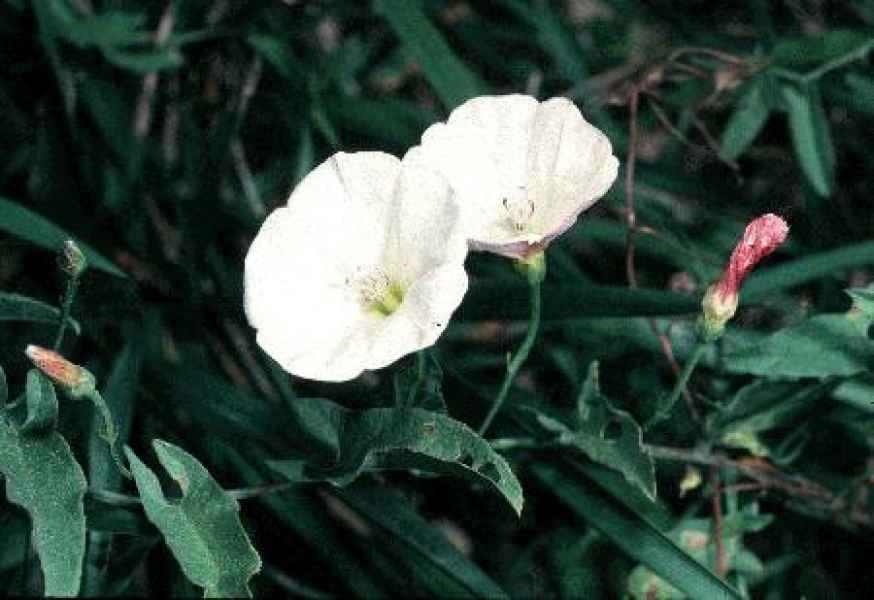
Bindweed Flowers
Noxious Weeds
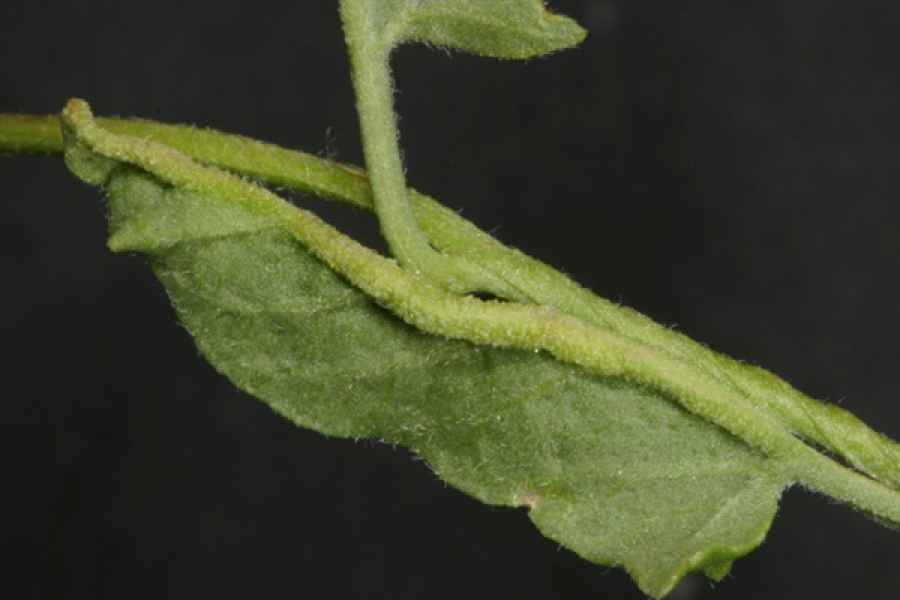
Bindweed Mite Injury
Noxious Weeds
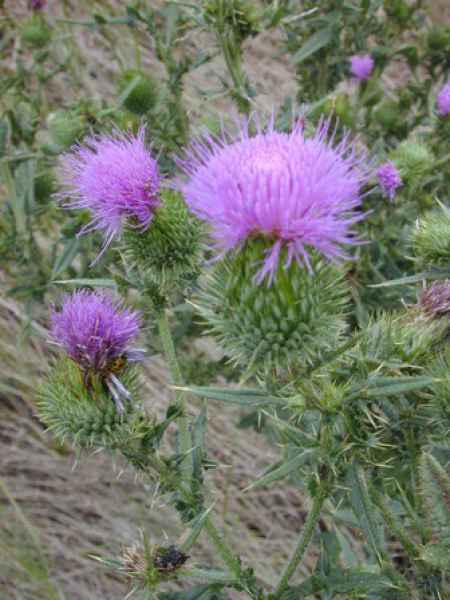
Bull Thistle Flower
Noxious Weeds
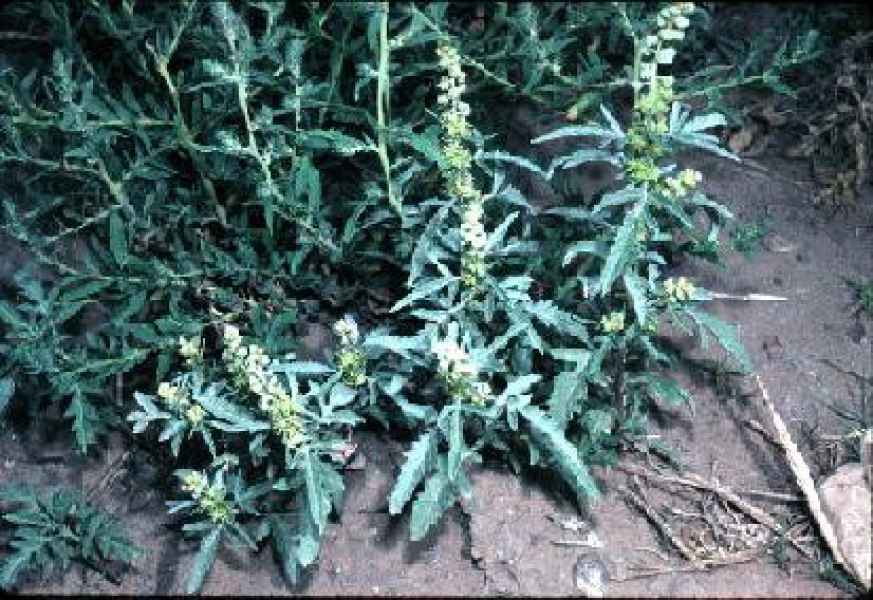
Burr Ragweed
Noxious Weeds
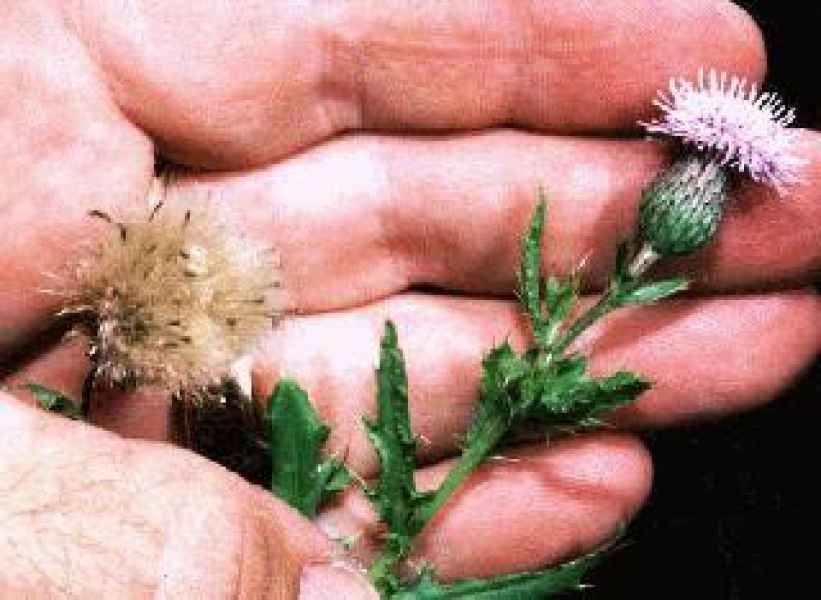
Canada Thistle Flower
Noxious Weeds
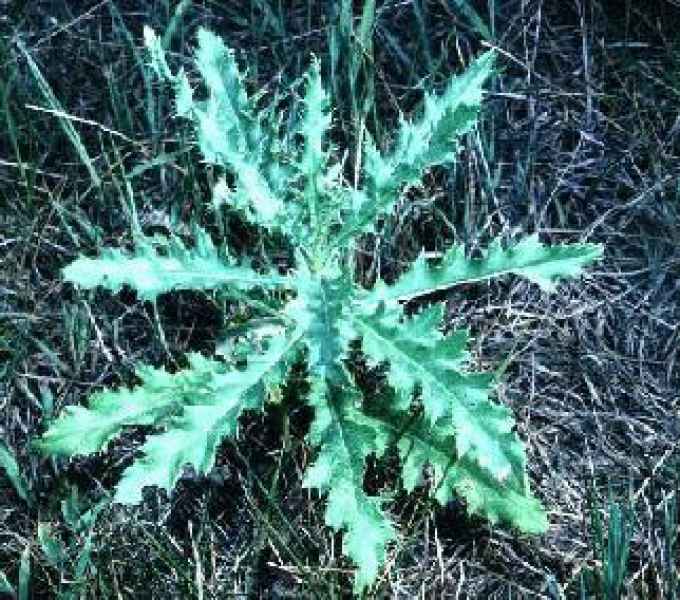
Canada Thistle Plant
Noxious Weeds
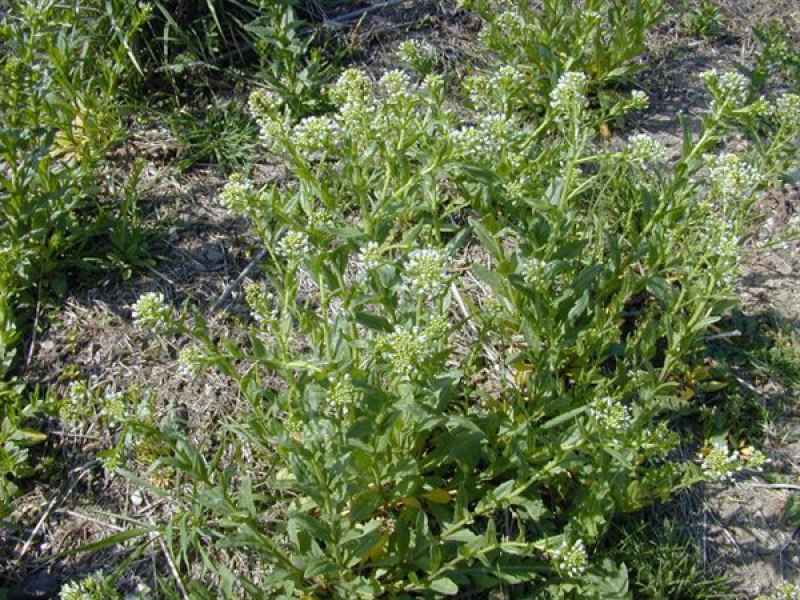
Hoary Cress Flower
Noxious Weeds
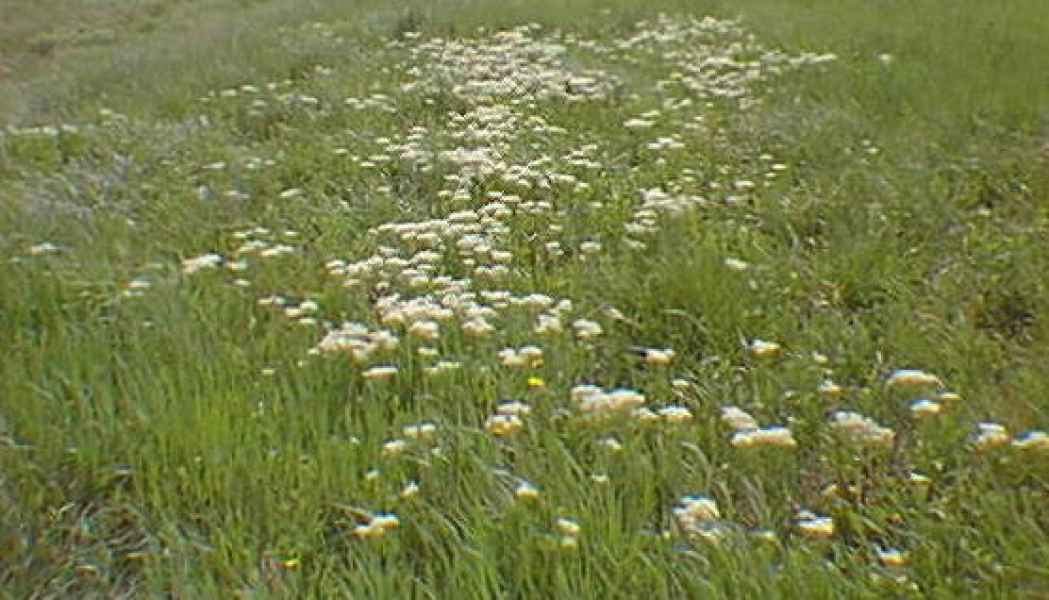
Hoary Cress Infestation
Noxious Weeds
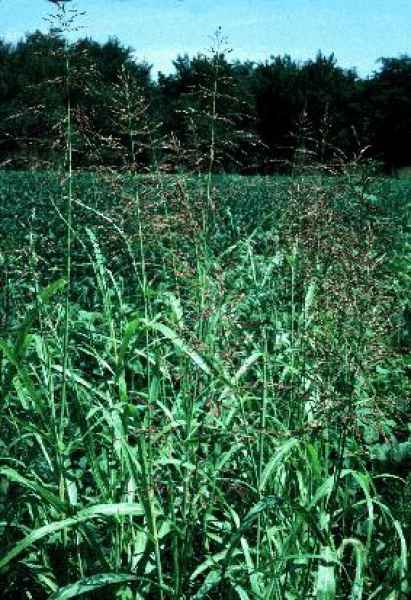
Johnsongrass
Noxious Weeds

Johnsongrass Plants
Noxious Weeds
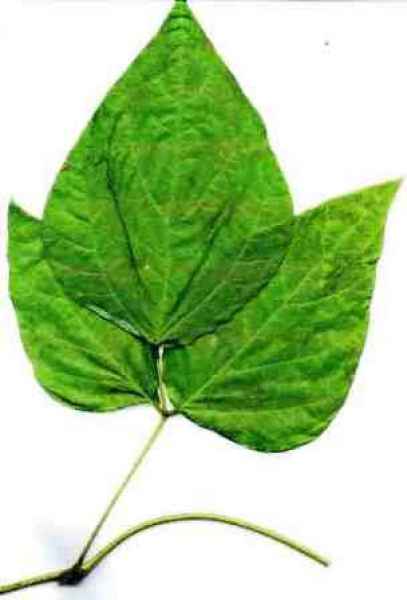
Kudzu Leaf Stem
Noxious Weeds

Kudzu Plant
Noxious Weeds
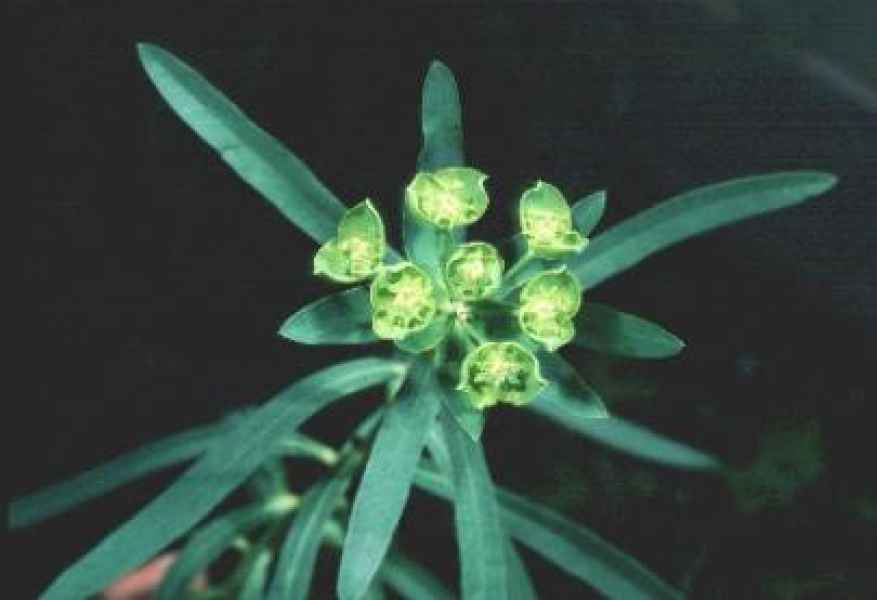
Leafy Spurge
Noxious Weeds
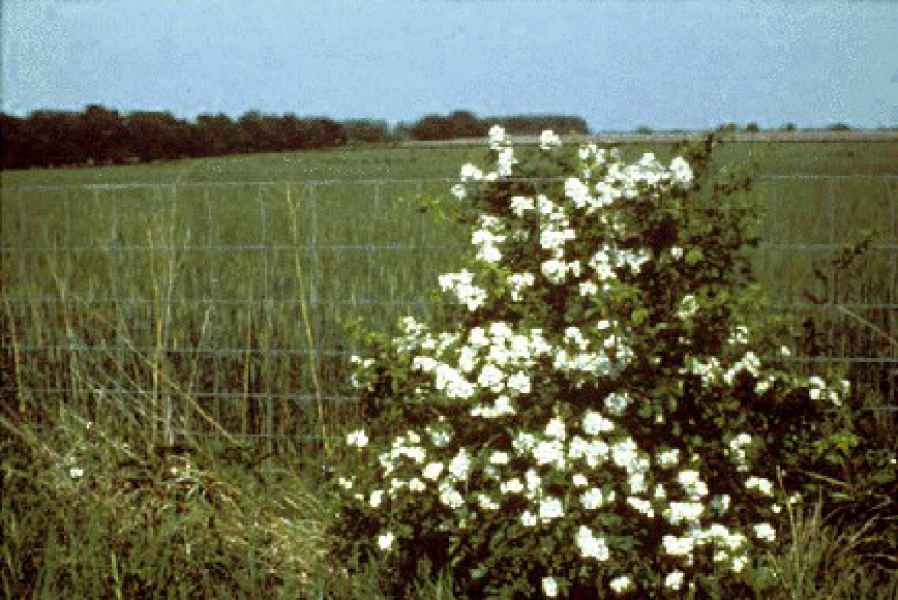
Multi Flora Rose
Noxious Weeds

Musk Thistle
Noxious Weeds
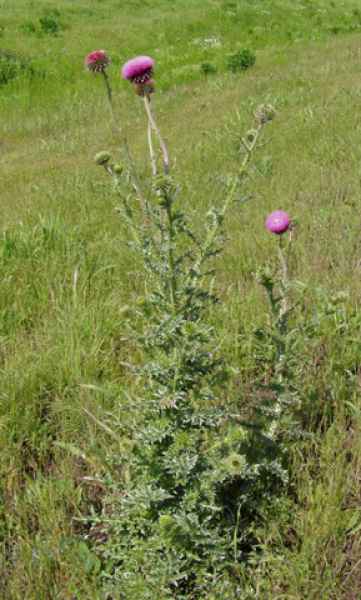
Musk Thistle Bolt
Noxious Weeds
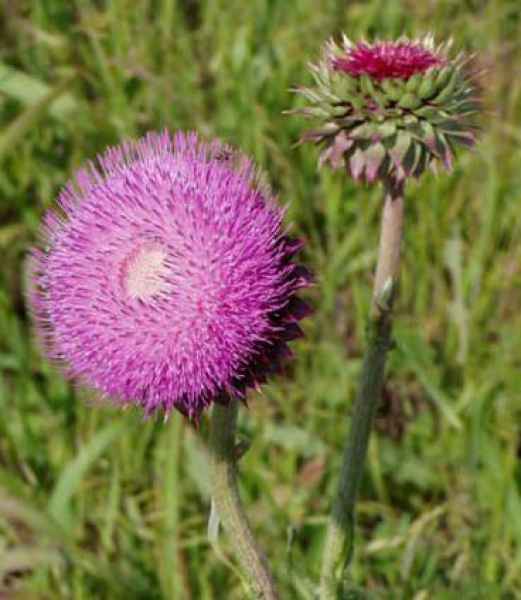
Musk Thistle Flower
Noxious Weeds
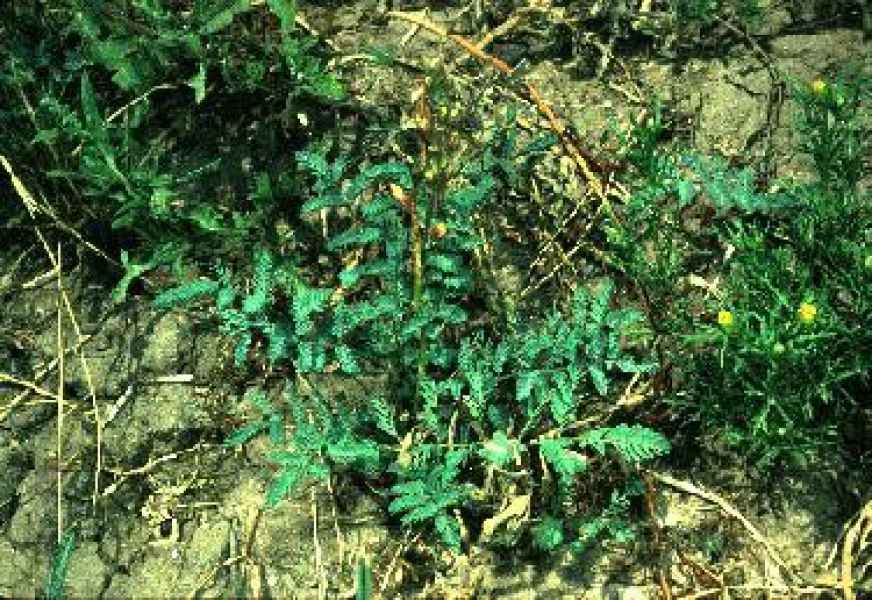
Pignut
Noxious Weeds
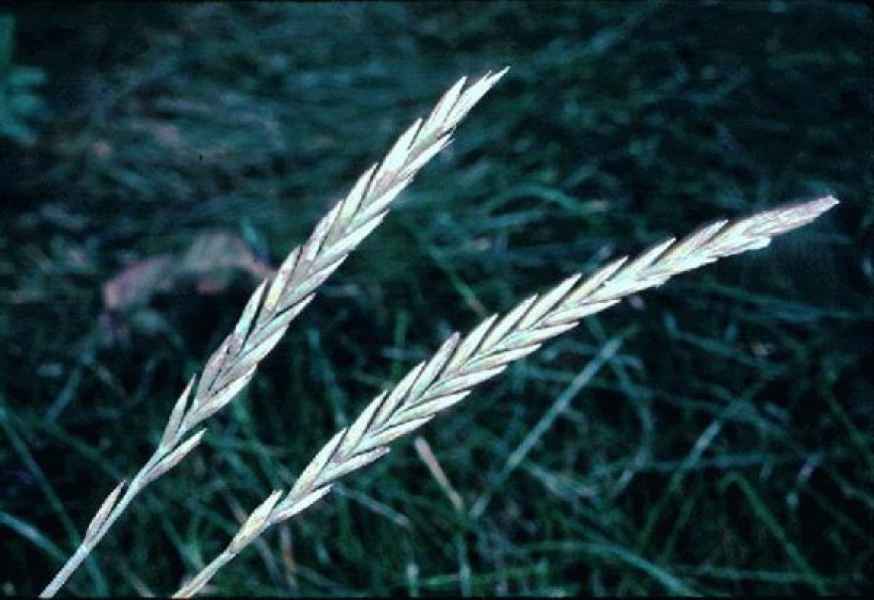
Quackgrass Seed Heads
Noxious Weeds

Russian Knapweed
Noxious Weeds
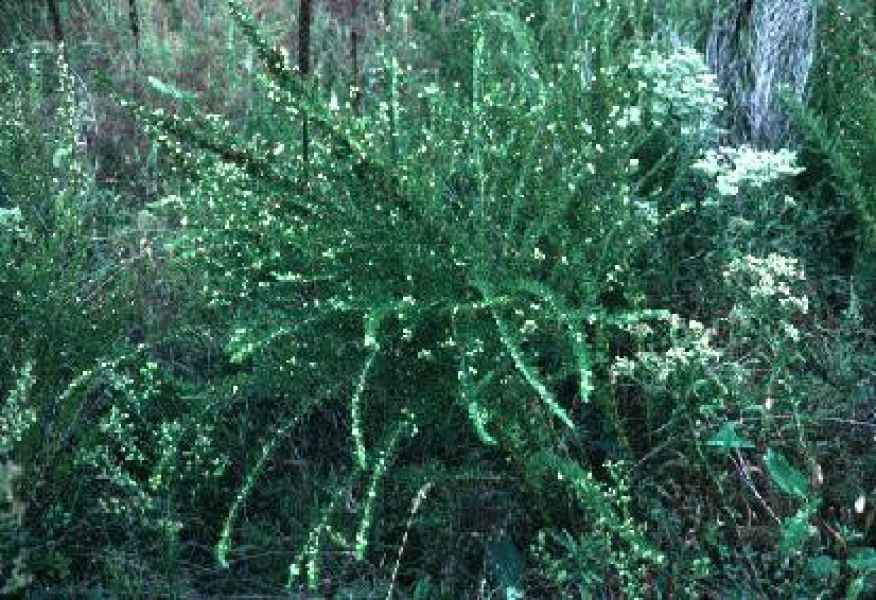
Sericea Lespedeza
Noxious Weeds
